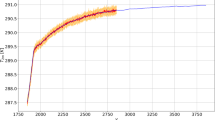Abstract
Impulse-response-function (IRF) models are designed for applications requiring a large number of climate change simulations, such as multi-scenario climate impact studies or cost-benefit integrated-assessment studies. The models apply linear response theory to reproduce the characteristics of the climate response to external forcing computed with sophisticated state-of-the-art climate models like general circulation models of the physical ocean-atmosphere system and three-dimensional oceanic-plus-terrestrial carbon cycle models. Although highly computer efficient, IRF models are nonetheless capable of reproducing the full set of climate-change information generated by the complex models against which they are calibrated. While limited in principle to the linear response regime (less than about 3 ∘C global-mean temperature change), the applicability of the IRF model presented has been extended into the nonlinear domain through explicit treatment of the climate system's dominant nonlinearities: CO2 chemistry in ocean water, CO2 fertilization of land biota, and sublinear radiative forcing. The resultant nonlinear impulse-response model of the coupled carbon cycle-climate system (NICCS) computes the temporal evolution of spatial patterns of climate change for four climate variables of particular relevance for climate impact studies: near-surface temperature, cloud cover, precipitation, and sea level. The space-time response characteristics of the model are derived from an EOF analysis of a transient 850-year greenhouse warming simulation with the Hamburg atmosphere-ocean general circulation model ECHAM3-LSG and a similar response experiment with the Hamburg carbon cycle model HAMOCC. The model is applied to two long-term CO2 emission scenarios, demonstrating that the use of all currently estimated fossil fuel resources would carry the Earth's climate far beyond the range of climate change for which reliable quantitative predictions are possible today, and that even a freezing of emissions to present-day levels would cause a major global warming in the long term.
Similar content being viewed by others
Author information
Authors and Affiliations
Additional information
Received: 28 January 2000 / Accepted: 9 March 2001
Rights and permissions
About this article
Cite this article
Hooss, G., Voss, R., Hasselmann, K. et al. A nonlinear impulse response model of the coupled carbon cycle-climate system (NICCS). Climate Dynamics 18, 189–202 (2001). https://doi.org/10.1007/s003820100170
Issue Date:
DOI: https://doi.org/10.1007/s003820100170




